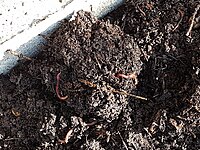
Photo from wikipedia
Abstract Three field studies have been performed, in order to assess changes in the composition of soil animal communities, soil physical and chemical features and mineralization processes with Norway spruce… Click to show full abstract
Abstract Three field studies have been performed, in order to assess changes in the composition of soil animal communities, soil physical and chemical features and mineralization processes with Norway spruce (Picea abies, L.) phases of the forest cycle. These field studies were conducted in three sites that differed in the acidity level of their bedrock (acidic, sub-acidic, and basic). The influence of exposure, through modifying microclimatic conditions, was also taken in consideration by comparing north and south exposures at each site. The data issued from each of these studies have already been published separately, and the aim of the present paper is to confront the three series of data in order to assess: 1) The general trend of changes in soil invertebrate communities, humus forms and mineralization processes with the age of spruce; 2) The impact of the type of bedrock and exposure on these changes. The results indicate that deep modifications occurred in animal communities, humus forms and soil functioning among clearing, regeneration and mature tree stands. The changes consist in an increase of Humus Index and the density of mites, especially oribatids, with a decrease in mineralization rate and animal diversity, from clearing to mature stands. Regeneration stands occupy an intermediate level as regards soil features but cumulates highest densities of most groups, highest levels of zoological diversity and mineralization activity. This higher level of richness and functional activity in regeneration stands could be explained by a more heterogeneous habitat in this phase of the forest cycle. Our results thus support the hypothesis that forest dynamics drives soil functioning and diversity, at least during the phase of intense growth of trees. The evolution of humus forms and animal communities along the developmental phases of forest stands were considerably more pronounced in south-facing sites than in north-facing sites. Unexpectedly, no increase in animal diversity was observed from the more to the less acidic bedrock. Suggestions for forest management are proposed.
Journal Title: Applied Soil Ecology
Year Published: 2017
Link to full text (if available)
Share on Social Media: Sign Up to like & get
recommendations!